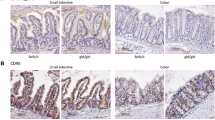Summary
The effects of epidermal growth factor (EGF) on the cell production rate throughout the gastrointestinal mucosa in adult rats and mice was studied. The vincristine arrest technique combined with the micro-dissection method was used to estimate the cell production rate in the crypt.
EGF showed trophic effects on some parts of the bowel, viz. duodenum, jejunum, ileum (5%, 50%, 95% along the bowel length respectively) and colon. But it showed no effect on the cell production rates in the gastric glands.
The response to EGF differed in rats and mice and at different times after the injection. EGF stimulates cell proliferation in the duodenal and ileal crypts in mice, and the jejunal and ileal crypts in rats 16 h after injection. On the other hand, EGF stimulates colonic crypt cell proliferation only, in mice 8 h after injection.
Similar content being viewed by others
References
Aherne WA, Camplejohn RS, Wright NA (1977) An introduction to cell population kinetics. Edward Arnold, London
Al-Dewachi HS, Wright NA, Appleton DR, Watson AJ (1975) The effect of starvation and refeeding on cell population kinetics in the rat small bowel mucosa. J Anat 199:106–121
Al-Dewachi HS, Wright NA, Appleton DR, Watson AJ (1976) Studies on the mechanism of diurnal variation of proliferative indices in the small bowel mucosa of the rat. Cell Tiss Kin 9:459–467
Al-Mukhtar MYT, Polak JM, Bloom SR, Wright NA (1982) The search for appropriate measurements of proliferative and morphological statis in studies of intestinal adaptation. In: Dowling HR, Robinson EJ (ed) Intestinal adaptation.
Al-Nafussi AI, Wright NA (1982) Circadian rhythm in the rate of cellular proliferation and in the size of the functional compartment of mouse jejunal epithelium. Virchows Arch [Cell Pathol] 40:71–79
Carpenter G, Cohen S (1976)125I-labelled human epidermal growth factor. Binding, internalization and degradation in human fibroblasts. J Cell Biol 71:159–171
Cohen S (1962) Isolation of a mouse submaxillary gland protein accelerating incisor eruption and eyelid opening in the newborn animal. J Biol Chem 237:1555–1562
Cohen S, Elliott GA (1963) The stimulation of epidermal keratinisation by a protein isolated from the submaxillary gland of the mouse. J Invest Dermatol 40:1–5
Cohen S, Taylor JM (1974) Epidermal growth factor; chemical and biological characterisation. Recent Prog Horm Res 30:533–550
Elder JB, Williams G, Lacey B, Gregory H (1978) Cellular localisation of human urogastrone/ epidermal growth factor. Nature 271:466–467
Feldman EJ, Aures D, Grossman MI (1978) Epidermal growth factor stimulates ornithine decarboxylase activity in the digestive tract of mouse. Proceedings of the Society for experimental biology and medicine 159:400–402
Forgue-Lafitte MG, Laburthe M, Chamblier MC, Moody AJ, Rosselin G (1980) Demonstration of specific receptors for EGF urogastrone in isolated rat intestinal epithelial cells. FEBS Lett 114:243–246
Gregory H (1973) Isolation and structure of urogastrone and its relationship to epidermal growth factor. Nature 257:325–327
Gregory H, Walsh S, Hopkins CR (1979) The identification of urogastrone in serum, saliva and gastric juice. Gastroenterology 77 (2): 313–318
Gospodarowicz D, Greenberg G, Bialecki H, Zetter BR (1978) Factors involved in the modulation of cell proliferation in vivo and in vitro. The role of fibroblast and epidermal growth factors in the proliferative response of mammalian cells. In Vitro 14:85–118
Hirata Y, Orth DN (1979) Conversion of high molecular weight human epidermal growth factor (HEGF)/urogastrone (UG) to small molecular weight HEGF/UG by mouse EGF-associated argenine esterase. J Clin Endocrinol Metab 49 (3): 481–483
Hollenberg MD (1975) Receptors for insulin and epidermal growth factor: Relation to synthesis of DNA in cultured rabbit lens epithelium. Arch Biochem Biophys 171:371–377
Hollenberg MD, Cuatrecasas MM (1973) Epidermal growth factor: receptors in human fibroblast and modulation of the action by cholera toxin. Proc Natl Acad Sci USA 70:2864–2868
Hollenberg MD, Cuatrecasas P (1975) Insulin and epidermal growth factor. Human fibroblast receptors related to deoxyribonucleic acid synthesis and amino acid uptake. J Biol Chem 250:3845–3853
Holley RW, Armour R, Baldwin JH, Brown KD, Yeh YC (1977) Density-dependent regulation of growth of BCS-1 cells in cell culture: control of growth by serum factors. Prod Natl Acad Sci. USA 74 (ii), 5046–5050
Johnson LR, Guthrie PD (1980) Stimulation of rat oxyntic gland mucosal growth by epidermal growth factor. Am J Physiol 238: G45–49
Maurer HR (1981) Potential pitfalls of3H Thymidine techniques to measure cell proliferation. Cell Tiss Kin 14:111–120
Potten CS, Shlemon E, Al-Bawari SE, Hume WJ, Searle J (1977) Circadian rhythms of presumptive stem cells in three different epithelia of the mouse. Cell Tiss Kin 10:557–568
Sandweiss DG, Saltzstein HC, Farbman AA (1939) The relation of sex hormones to peptic ulcer. Am J Dig Dis 6:6–12
Scheving LA, Yeh YC, Tsai TH, Scheving LE (1979) Circadian phase-dependent stimulatory effects of epidermal growth factor on deoxyribonucleic acid synthesis in the tongue, oesophagus and stomach of the adult male mouse. Endocrinology 105:1475–1480
Sigdestad CP, Bauman J, Lesher SW (1969) Diurnal fluctuation in the number of cells in mitosis and DNA synthesis in the jejunum of the mouse. Exp Cell Res 58:159–162
Author information
Authors and Affiliations
Rights and permissions
About this article
Cite this article
Al-Nafussi, A.I., Wright, N.A. The effect of epidermal growth factor (EGF) on cell proliferation of the gastrointestinal mucosa in rodents. Virchows Archiv B Cell Pathol 40, 63–69 (1982). https://doi.org/10.1007/BF02932851
Received:
Accepted:
Issue Date:
DOI: https://doi.org/10.1007/BF02932851




